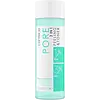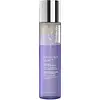What's inside
What's inside
 Key Ingredients
Key Ingredients

 Benefits
Benefits

 Concerns
Concerns

 Ingredients Side-by-side
Ingredients Side-by-side

Water
Skin ConditioningGlycerin
HumectantMandelic Acid
AntimicrobialButylene Glycol
HumectantCamellia Sinensis Leaf Extract
AntimicrobialSalicylic Acid
MaskingEnantia Chlorantha Bark Extract
Skin ConditioningTocopherol
AntioxidantAllantoin
Skin ConditioningEthylhexylglycerin
Skin ConditioningOleanolic Acid
Skin ConditioningSodium Hydroxide
BufferingCitric Acid
BufferingPhenoxyethanol
PreservativeSodium Benzoate
MaskingPotassium Sorbate
PreservativeWater
Skin ConditioningDimethicone
EmollientSqualane
EmollientHexylene Glycol
EmulsifyingButylene Glycol
HumectantSodium Chloride
MaskingGlycerin
HumectantSodium Hyaluronate
HumectantMyristyl Nicotinate
Skin ConditioningGlycyrrhiza Uralensis Root Extract
Skin ConditioningDaucus Carota Sativa Root Extract
Skin ConditioningRice Amino Acids
Skin ConditioningDiglucosyl Gallic Acid
Beta-Carotene
Skin ConditioningJania Rubens Extract
Skin ConditioningGlycine Soja Oil
EmollientBoswellia Serrata Gum
MaskingMandelic Acid
AntimicrobialLeuconostoc/Radish Root Ferment Filtrate
AntimicrobialMalic Acid
BufferingSodium Carrageenan
Emulsion StabilisingLactic Acid
BufferingBacillus/Sea Salt Ferment Filtrate
Skin ConditioningDisodium EDTA
Honey
HumectantSalicylic Acid
MaskingAminomethyl Propanol
BufferingCitric Acid
BufferingEthylhexylglycerin
Skin ConditioningTocopherol
AntioxidantDipropylene Glycol
HumectantPentylene Glycol
Skin ConditioningParfum
MaskingCetrimonium Chloride
AntimicrobialPhenoxyethanol
PreservativeBenzoic Acid
MaskingBenzyl Benzoate
AntimicrobialGeraniol
PerfumingBenzyl Salicylate
PerfumingCitronellol
PerfumingCitral
PerfumingLimonene
PerfumingLinalool
PerfumingBenzyl Alcohol
PerfumingCI 42090
Cosmetic ColorantCI 17200
Cosmetic ColorantWater, Dimethicone, Squalane, Hexylene Glycol, Butylene Glycol, Sodium Chloride, Glycerin, Sodium Hyaluronate, Myristyl Nicotinate, Glycyrrhiza Uralensis Root Extract, Daucus Carota Sativa Root Extract, Rice Amino Acids, Diglucosyl Gallic Acid, Beta-Carotene, Jania Rubens Extract, Glycine Soja Oil, Boswellia Serrata Gum, Mandelic Acid, Leuconostoc/Radish Root Ferment Filtrate, Malic Acid, Sodium Carrageenan, Lactic Acid, Bacillus/Sea Salt Ferment Filtrate, Disodium EDTA, Honey, Salicylic Acid, Aminomethyl Propanol, Citric Acid, Ethylhexylglycerin, Tocopherol, Dipropylene Glycol, Pentylene Glycol, Parfum, Cetrimonium Chloride, Phenoxyethanol, Benzoic Acid, Benzyl Benzoate, Geraniol, Benzyl Salicylate, Citronellol, Citral, Limonene, Linalool, Benzyl Alcohol, CI 42090, CI 17200
 Reviews
Reviews

Ingredients Explained
These ingredients are found in both products.
Ingredients higher up in an ingredient list are typically present in a larger amount.
Butylene Glycol (or BG) is used within cosmetic products for a few different reasons:
Overall, Butylene Glycol is a safe and well-rounded ingredient that works well with other ingredients.
Though this ingredient works well with most skin types, some people with sensitive skin may experience a reaction such as allergic rashes, closed comedones, or itchiness.
Learn more about Butylene GlycolCitric Acid is an alpha hydroxy acid (AHA) naturally found in citrus fruits like oranges, lemons, and limes.
Like other AHAs, citric acid can exfoliate skin by breaking down the bonds that hold dead skin cells together. This helps reveal smoother and brighter skin underneath.
However, this exfoliating effect only happens at high concentrations (20%) which can be hard to find in cosmetic products.
Due to this, citric acid is usually included in small amounts as a pH adjuster. This helps keep products slightly more acidic and compatible with skin's natural pH.
In skincare formulas, citric acid can:
While it can provide some skin benefits, research shows lactic acid and glycolic acid are generally more effective and less irritating exfoliants.
Most citric acid used in skincare today is made by fermenting sugars (usually from molasses). This synthetic version is identical to the natural citrus form but easier to stabilize and use in formulations.
Read more about some other popular AHA's here:
Learn more about Citric AcidEthylhexylglycerin (we can't pronounce this either) is commonly used as a preservative and skin softener. It is derived from glyceryl.
You might see Ethylhexylglycerin often paired with other preservatives such as phenoxyethanol. Ethylhexylglycerin has been found to increase the effectiveness of these other preservatives.
Glycerin is already naturally found in your skin. It helps moisturize and protect your skin.
A study from 2016 found glycerin to be more effective as a humectant than AHAs and hyaluronic acid.
As a humectant, it helps the skin stay hydrated by pulling moisture to your skin. The low molecular weight of glycerin allows it to pull moisture into the deeper layers of your skin.
Hydrated skin improves your skin barrier; Your skin barrier helps protect against irritants and bacteria.
Glycerin has also been found to have antimicrobial and antiviral properties. Due to these properties, glycerin is often used in wound and burn treatments.
In cosmetics, glycerin is usually derived from plants such as soybean or palm. However, it can also be sourced from animals, such as tallow or animal fat.
This ingredient is organic, colorless, odorless, and non-toxic.
Glycerin is the name for this ingredient in American English. British English uses Glycerol/Glycerine.
Learn more about GlycerinMandelic Acid is an alpha hydroxy acid (AHA).
Like other AHAs, it helps exfoliate the surface of the skin by breaking down the bonds that hold dead skin cells together. This helps reveal smoother and brighter skin underneath.
Mandelic acid helps with:
Due to it having a larger molecular size than glycolic acid, mandelic acid is able to penetrate the skin more slowly and evenly. This makes it gentler and less irritating, making it a great option for sensitive or beginner skin.
Despite being milder, mandelic acid is still an effective exfoliant that improves skin texture and tone over time.
What makes mandelic acid stand out from other AHAs? It has antibacterial and antioxidant properties.
These traits make it a great option for acne-prone or problem skin by reducing active breakouts and fading post-acne marks. Studies show that mandelic acid (especially when combined with salicylic acid) can significantly reduce pimples and hyperpigmentation while causing fewer side effects than stronger acids.
Mandelic acid is effective in concentrations of 5% and up with an ideal pH range of 3-4 for at-home use.
Like other AHAs, it’s important to wear sunscreen daily to protect your newly exfoliated skin.
However, unlike glycolic acid, mandelic acid is light-sensitive. Be sure your mandelic acid is packaged in opaque containers to ensure it stays stable and effective.
In short, mandelic acid is a gentle yet powerful AHA that exfoliates, brightens, and helps clarify skin while keeping irritation low. Its antibacterial action makes it especially beneficial for those with acne-prone, sensitive, or uneven skin, offering smoother, clearer, and more even-toned results over time.
Read more about some other popular AHA's here:
Learn more about Mandelic AcidPhenoxyethanol is a preservative that has germicide, antimicrobial, and aromatic properties. Studies show that phenoxyethanol can prevent microbial growth. By itself, it has a scent that is similar to that of a rose.
It's often used in formulations along with Caprylyl Glycol to preserve the shelf life of products.
Salicylic Acid (also known as beta hydroxy acid or BHA) is a well-known ingredient for treating skin that struggles with acne and clogged pores. It exfoliates both the skin's surface and deep within the pores to help clear out buildup, control oil, and reduce inflammation.
Unlike AHAs (alpha hydroxy acids), salicylic acid is oil-soluble. This allows it to penetrate into pores which makes it especially effective for treating blackheads and preventing future breakouts.
Salicylic acid is also known for its soothing properties. It has a similar structure to aspirin and can calm inflamed or irritated skin, making it a good option for acne-prone skin that is also sensitive.
Concentrations of 0.5-2% are recognized by the U.S. FDA as an over-the-counter topical acne product.
It can cause irritation and/or dryness if one's skin already has a compromised moisture barrier, so it's best to focus on repairing that before introducing this ingredient into your routine.
While salicylic acid does not increase sun sensitivity, it’s still important to wear sunscreen daily to protect your skin.
If you are looking for the ingredient called BHA or Butylated Hydroxyanisole, click here.
Learn more about Salicylic AcidTocopherol (also known as Vitamin E) is a common antioxidant used to help protect the skin from free-radicals and strengthen the skin barrier. It's also fat soluble - this means our skin is great at absorbing it.
Vitamin E also helps keep your natural skin lipids healthy. Your lipid skin barrier naturally consists of lipids, ceramides, and fatty acids. Vitamin E offers extra protection for your skin’s lipid barrier, keeping your skin healthy and nourished.
Another benefit is a bit of UV protection. Vitamin E helps reduce the damage caused by UVB rays. (It should not replace your sunscreen). Combining it with Vitamin C can decrease sunburned cells and hyperpigmentation after UV exposure.
You might have noticed Vitamin E + C often paired together. This is because it is great at stabilizing Vitamin C. Using the two together helps increase the effectiveness of both ingredients.
There are often claims that Vitamin E can reduce/prevent scarring, but these claims haven't been confirmed by scientific research.
Learn more about TocopherolWater. It's the most common cosmetic ingredient of all. You'll usually see it at the top of ingredient lists, meaning that it makes up the largest part of the product.
So why is it so popular? Water most often acts as a solvent - this means that it helps dissolve other ingredients into the formulation.
You'll also recognize water as that liquid we all need to stay alive. If you see this, drink a glass of water. Stay hydrated!
Learn more about Water